
Excertos do catálogo
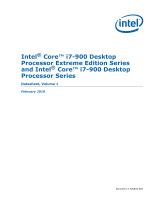
Intel® Core™ i7-900 Desktop Processor Extreme Edition Series and Intel® Core™ i7-900 Desktop Processor Series Datasheet, Volume 1 February 2010
Abrir o catálogo na página 1
INFORMATION IN THIS DOCUMENT IS PROVIDED IN CONNECTION WITH INTEL PRODUCTS. NO LICENSE, EXPRESS OR IMPLIED, BY ESTOPPEL OR OTHERWISE, TO ANY INTELLECTUAL PROPERTY RIGHTS IS GRANTED BY THIS DOCUMENT. EXCEPT AS PROVIDED IN INTEL'S TERMS AND CONDITIONS OF SALE FOR SUCH PRODUCTS, INTEL ASSUMES NO LIABILITY WHATSOEVER, AND INTEL DISCLAIMS ANY EXPRESS OR IMPLIED WARRANTY, RELATING TO SALE AND/OR USE OF INTEL PRODUCTS INCLUDING LIABILITY OR WARRANTIES RELATING TO FITNESS FOR A PARTICULAR PURPOSE, MERCHANTABILITY, OR INFRINGEMENT OF ANY PATENT, COPYRIGHT OR OTHER INTELLECTUAL PROPERTY RIGHT. INTEL...
Abrir o catálogo na página 2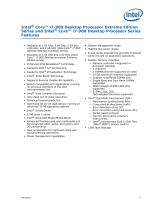
Intel® Core™ i7-900 Desktop Processor Extreme Edition Series and Intel® Core™ i7-900 Desktop Processor Series Features • Available at 3.20 GHz, 3.06 GHz, 2.93 GHz, 2.80 GHz, and 2.66 GHz (Intel Core™ i7-900 desktop desktop processor series) • Available at 3.33 GHz and 3.20 GHz (Intel Core™ i7-900 desktop processor Extreme Edition series) ® • Enhanced Intel Speedstep • Supports Intel® 64 Architecture • Supports Intel® Virtualization Technology • Intel® Turbo Boost Technology • Supports Execute Disable Bit capability • Binary compatible with applications running on previous members of the...
Abrir o catálogo na página 7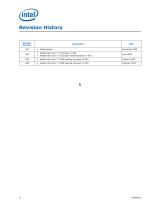
Revision History Revision Number Initial release Added Intel Core™ i7 processor i7-950 Added Intel Core™ i7 processor Extreme Edition i7-975 Added Intel Core™ i7-900 desktop processor i7-960 Added Intel Core™ i7-900 desktop processor i7-930
Abrir o catálogo na página 8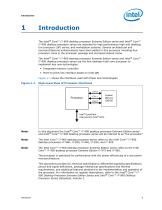
Introduction The Intel® Core™ i7-900 desktop processor Extreme Edition series and Intel® Core™ i7-900 desktop processor series are intended for high performance high-end desktop, Uni-processor (UP) server, and workstation systems. Several architectural and microarchitectural enhancements have been added to this processor including four processor cores in the processor package and increased shared cache. The Intel® Core™ i7-900 desktop processor Extreme Edition series and Intel® Core™ i7-900 desktop processor series are the first desktop multi-core processor to implement key new...
Abrir o catálogo na página 9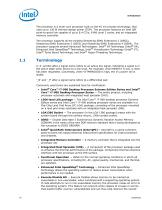
The processor is a multi-core processor built on the 45 nm process technology, that uses up to 130 W thermal design power (TDP). The processor features an Intel QPI point-to-point link capable of up to 6.4 GT/s, 8 MB Level 3 cache, and an integrated memory controller. The processor supports all the existing Streaming SIMD Extensions 2 (SSE2), Streaming SIMD Extensions 3 (SSE3) and Streaming SIMD Extensions 4 (SSE4). The processor supports several Advanced Technologies: Intel® 64 Technology (Intel® 64), Enhanced Intel SpeedStep® Technology, Intel® Virtualization Technology (Intel® VT),...
Abrir o catálogo na página 10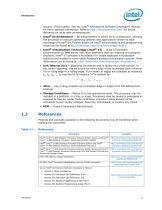
• Jitter — Any timing variation of a transition edge or edges from the defined Unit Interval. • Storage Conditions — Refers to a non-operational state. The processor may be installed in a platform, in a tray, or loose. Processors may be sealed in packaging or exposed to free air. Under these conditions, processor lands should not be connected to any supply voltages, have any I/Os biased, or receive any clocks. • OEM — Original Equipment Manufacturer. References Material and concepts available in the following documents may be beneficial when reading this document. References Document Intel®...
Abrir o catálogo na página 11
Electrical Specifications Electrical Specifications Intel® QPI Differential Signaling The processor provides an Intel QPI port for high speed serial transfer between other Intel QPI-enabled components. The Intel QPI port consists of two unidirectional links (for transmit and receive). Intel QPI uses a differential signalling scheme where pairs of opposite-polarity (D_P, D_N) signals are used. On-die termination (ODT) is provided on the processor silicon and termination is to VSS. Intel chipsets also provide ODT; thus, eliminating the need to terminate the Intel QPI links on the system...
Abrir o catálogo na página 13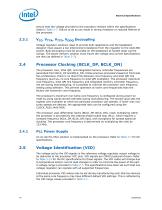
Electrical Specifications ensure that the voltage provided to the processor remains within the specifications listed in Table 2-7. Failure to do so can result in timing violations or reduced lifetime of the processor. VCC, VTTA, VTTD, VDDQ Decoupling Voltage regulator solutions need to provide bulk capacitance and the baseboard designer must assure a low interconnect resistance from the regulator to the LGA1366 socket. Bulk decoupling must be provided on the baseboard to handle large current swings. The power delivery solution must insure the voltage and current specifications are met (as...
Abrir o catálogo na página 14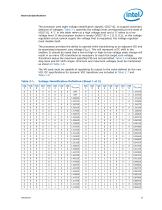
Electrical Specifications The processor uses eight voltage identification signals, VID[7:0], to support automatic selection of voltages. Table 2-1 specifies the voltage level corresponding to the state of VID[7:0]. A ‘1’ in this table refers to a high voltage level and a ‘0’ refers to a low voltage level. If the processor socket is empty (VID[7:0] = 11111111), or the voltage regulation circuit cannot supply the voltage that is requested, the voltage regulator must disable itself. The processor provides the ability to operate while transitioning to an adjacent VID and its associated...
Abrir o catálogo na página 15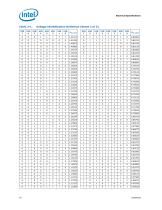
Electrical Specifications Voltage Identification Definition (Sheet 2 of 3)
Abrir o catálogo na página 16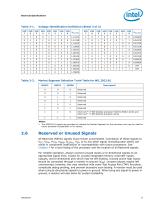
Electrical Specifications Voltage Identification Definition (Sheet 3 of 3) Market Segment Selection Truth Table for MS_ID[2:0] Description1 Intel Core™ i7-900 desktop processor Extreme Edition series and Intel Core™ i7-900 desktop processor series Notes: 1. The MSID[2:0] signals are provided to indicate the Market Segment for the processor and may be used for future processor compatibility or for keying. Reserved or Unused Signals All Reserved (RSVD) signals must remain unconnected. Connection of these signals to VCC, VTTA, VTTD, VDDQ, VCCPLL, VSS, or to any other signal (including each...
Abrir o catálogo na página 17Todos os catálogos e folhetos técnicos Intel
-
10th Gen Intel® Core
7 Páginas
-
10th Gen
8 Páginas
-
nuc-celeron
4 Páginas
-
Intel® Optane™ SSD DC P4800X Series
2 Páginas
-
Intel® NUC 8 Home Mini PC
4 Páginas
-
Intel® Xeon® Scalable Platform
14 Páginas
-
Intel® Ethernet Controller XL710
1726 Páginas
-
Intel® Xeon® Processor E3-1200 v5
130 Páginas
-
Intel® Quark™ SoC X1000 Series
934 Páginas
-
Intel® X99 Chipset
4 Páginas
-
Mini PC - Intel® NUC Kit DC3217IYE
4 Páginas
-
Mini PC?Intel® NUC Kit NUC5i5RYH
4 Páginas
-
Intel® Desktop Board DQ67EP
4 Páginas
-
Intel® Ethernet Switch FM4000
270 Páginas
-
Intel® NUC Board DE3815TYBE
82 Páginas
-
S2600GZ and S2600GL
245 Páginas
-
Intel® Solid-State Drive DC P3700 Series
42 Páginas
-
i7-lga2011
314 Páginas
-
c600-series
936 Páginas
-
b75-express
4 Páginas
-
desktop-board
4 Páginas
-
3rd-gen-core-desktops
2 Páginas
-
/3rd-gen-core
2 Páginas
Catálogos arquivados
-
Intel® Server System SR2600UR
8 Páginas
-
Intel® Ethernet Controllers
2 Páginas
-
Intel® 3450 Chipset
2 Páginas
-
Intel® 3000 and 3010 Chipset
4 Páginas
-
Intel® X58 Express Chipset
4 Páginas
-
Intel® Server Board S1200BT
8 Páginas
-
Intel® Desktop Board DX58SO2
4 Páginas
-
Intel® Xeon® Processor 5000 Series Datasheet
104 Páginas
-
Intel® I/O Processor Overview
4 Páginas
































































































